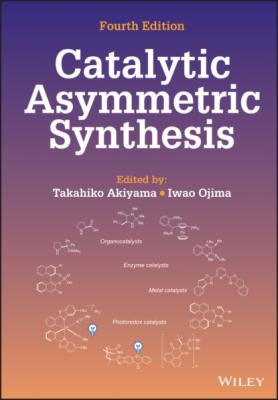Catalytic Asymmetric Synthesis. Группа авторов
Чтение книги онлайн.
Читать онлайн книгу Catalytic Asymmetric Synthesis - Группа авторов страница 26
 style="font-size:15px;"> 883 889
style="font-size:15px;"> 883 889884 890
885 891
CATALYTIC ASYMMETRIC SYNTHESIS
Fourth Edition
Edited By
TAKAHIKO AKIYAMA
Department of Chemistry
Gakushuin University
Tokyo
IWAO OJIMA
Department of Chemistry
SUNY Stony Brook
New York
This fourth edition first published 2022
© 2022 by John Wiley & Sons, Inc.
Edition history Catalytic Asymmetric Synthesis, 1st Edition, 1995, Ojima. ISBN: 978‐0‐471‐18625‐0 Catalytic Asymmetric Synthesis, 2nd Edition, 2004, Ojima. ISBN: 978‐0‐471‐22054‐1 Catalytic Asymmetric Synthesis, 3rd Edition, 2010, Ojima. ISBN 978‐0‐470‐17577‐4
All rights reserved. No part of this publication may be reproduced, stored in a retrieval system, or transmitted, in any form or by any means, electronic, mechanical, photocopying, recording or otherwise, except as permitted by law. Advice on how to obtain permission to reuse material from this title is available at http://www.wiley.com/go/permissions.
The right of Takahiko Akiyama and Iwao Ojima to be identified as the authors of the editorial material in this work has been asserted in accordance with law.
Registered Office John Wiley & Sons, Inc., 111 River Street, Hoboken, NJ 07030, USA
Editorial Office John Wiley & Sons, Inc., 111 River Street, Hoboken, NJ 07030, USA
For details of our global editorial offices, customer services, and more information about Wiley products visit us at www.wiley.com.
Wiley also publishes its books in a variety of electronic formats and by print‐on‐demand. Some content that appears in standard print versions of this book may not be available in other formats.
Limit of Liability/Disclaimer of Warranty In view of ongoing research, equipment modifications, changes in governmental regulations, and the constant flow of information relating to the use of experimental reagents, equipment, and devices, the reader is urged to review and evaluate the information provided in the package insert or instructions for each chemical, piece of equipment, reagent, or device for, among other things, any changes in the instructions or indication of usage and for added warnings and precautions. While the publisher and authors have used their best efforts in preparing this book, they make no representations or warranties with respect to the accuracy or completeness of the contents of this work and specifically disclaim all warranties, including without limitation any implied warranties of merchantability or fitness for a particular purpose. No warranty may be created or extended by sales representatives, written sales materials or promotional statements for this work. This work is sold with the understanding that the publisher is not engaged in rendering professional services. The advice and strategies contained herein may not be suitable for your situation. You should consult with a professional where appropriate. Neither the publisher nor author shall be liable for any loss of profit or any other commercial damages, including but not limited to special, incidental, consequential, or other damages. The fact that an organization, website, or product is referred to in this work as a citation and/or potential source of further information does not mean that the publisher and authors endorse the information or services the organization, website, or product may provide or recommendations it may make. Further, readers should be aware that websites listed in this work may have changed or disappeared between when this work was written and when it is read. Neither the publisher nor authors shall be liable for any loss of profit or any other commercial damages, including but not limited to special, incidental, consequential, or other damages.
Library of Congress Cataloging‐in‐Publication Data applied for:
Hardback ISBN: 9781119736394
Cover Design: Wiley
Cover Images: © AVIcon/Shutterstock; Courtesy of Takahiko Akiyama
PREFACE
The first, second, and third editions of Catalytic Asymmetric Synthesis published in 1993, 2000, and 2010, respectively, were warmly received by research communities in academia and industries, from graduate students, research associates, faculty, staff, senior researchers, and others. Catalytic Asymmetric Synthesis has become a common tool for the synthesis of enantiopure compounds in both industry and academia.
The Nobel Prize in Chemistry 2001 was given to W. Knowles, K. B. Sharpless, and R. Noyori for their outstanding contributions to the advancement of catalytic asymmetric synthesis, using transition‐metal catalysis. Quite recently it was announced that Benjamin List and David MacMillan won the Nobel Prize in Chemistry 2021 for their work on the development of asymmetric organocatalysis, using small organic molecule. This is the second Nobel Prize given to the field of asymmetric catalysis, following the Nobel Prize in Chemistry 2001, which clearly indicates the profound importance of asymmetric catalysis.
More than 10 years have passed after the third edition was published, and 2010s has witnessed revolutionary advancement of asymmetric catalysis. Therefore, the publication of the fourth edition of this book series, capturing the highly innovative progress in this field, deemed in demand and was fully justified. In order to cover the revolutionary advances in the last decade, Takahiko Akiyama joined as the leading editor in this fourth edition.
In the first and second editions, chiral metal‐based catalysts played the central roles for the asymmetric synthesis because transition‐metal‐catalyzed enantioselective reactions were extensively studied, in particular, in the 1980s and 1990s. Organocatalysis, Lewis and Brønsted acids, C–H activation, carbon‐heteroatom bond forming reactions, and enzyme‐catalyzed reactions were introduced in the third edition.
After 2010, in addition to transition‐metal catalyzed reactions, organocatalysis, including Brønsted acids and C–H activation reactions, has been making remarkable advances. Photoredox catalysis emerged as a useful new synthetic reaction mainly after 2008 and has been rapidly growing and has become a critical methodology. Because the chapters in the third edition are still very informative and the methodologies described therein are still inspiring and stimulating even today, those methodologies are considered “classics” in catalytic asymmetric synthesis.
We